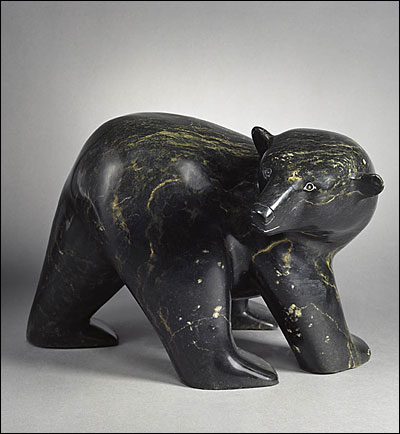
Nuna PARR, Polar Bear, 2002, serpentinite
Photo : Paul Dionne ( Musée d'Art Inuit Brousseau collection, Vieux Québec)
|
|
ENSEMBLE CONVENTUEL
DES JACOBINS DE TOULOUSE
CONSERVATION
69, rue Pargaminières
31000 Toulouse
INFORMATION :
Tél.: 05 61 22 21 92
site : www.jacobins.mairie-toulouse.fr
e-mail: jacobins@mairie-toulouse.fr
HOURS :
Open everyday, including holidays,from 10 am to 7 pm
Entrance though the Church, rue Lakanal.
ADMISSION FEES :
Full Price : 5 Euros
Concessions and Groups : 2,50 Euros
CURATORSHIP :
Monique Rey-Delqué, Directeur de l’Ensemble Conventuel des Jacobins et Chargée du Patrimoine de la Ville de Toulouse
PRESS CONTACT :
Agence KOM
Suzanne Manheimer
29, rue Valade
31000 TOULOUSE
Tél.: 05 34 416 412 Fax : 05 34 416 413
e-mail: agencekom@agencekom.com

|
Though their territory is as wide as a continent and spreads from Greenland to Alaska, only forty thousand Inuit live on the North-Canadian provinces. The artistic production of this small population is impressive, both by its quantity and by its diversity. Greatly due to the help of a passionate Canadian collector, Raymond Brousseau, the founder of the Inuit Museum of Quebec, and to the Rhône-Muséum Department, the Ensemble Conventuel des Jacobins was able to bring together an exceptional choice of sculptures that illustrates the commitment of the Inuit contemporary artists to restore a centuries-old civilization of oral tradition. Their art form really came to life in the 50s, at the very beginning of this people’s settling process.
The founding values
From the very beginning the Inuit culture has been in perfect harmony with the natural elements and has dialogued with the spirits. The role of the artists is important, and their success reflects on the whole community, while allowing them to provide not only for their families’ needs, but for those of their neighbors as well, in compliance with their traditional values. By using whale bones, basalt, ivory, or caribou wood the sculptors reveal to us the subtleties of the animal, human or mystic world, the fundamental role of the shaman, mediator between the visible and the invisible worlds, who is the only one who knows how to maintain the balance between the forces of the universe and how to intercede with the spirits. They speak of the vital part played by the animals, endowed with a soul, and the very particular link that unites the hunter to his prey. They also speak of their people’s customs and founding values, such as sharing, the complementary nature of the couple and the respect for the elders. Each one with his own style is the spokesperson of the history of a civilization.
Thousands of legendary spirits and heroes
These sculptures have the power to surpass the obstacles of language and time, to communicate directly with us. The Inuit sculptor is steeped in dreams. In spite of his new relations with people who are strangers to his people, he continues to bring his own mystic imagery to life. We can see the fascinating life of human beings and animals, either relaxing or tense, but always beaming with vitality. When we see or touch these objects we cannot help being filled with enthusiasm by the seal’s slender line, the muted power of the bear, the weight of the walrus, the wriggling of the trout or the rhythm of a flight of geese. And next to major figures of the Inuit mythology such as Sedna, the goddess of the sea, these works tell us the fascinating stories of thousands of other spirits and legendary heroes.
Illustration : Jolly ANINGMIUQ Transformation,1997, serpentinite
Photo : Paul Dionne ( Musée d'Art Inuit Brousseau collection, Vieux Québec)
|









